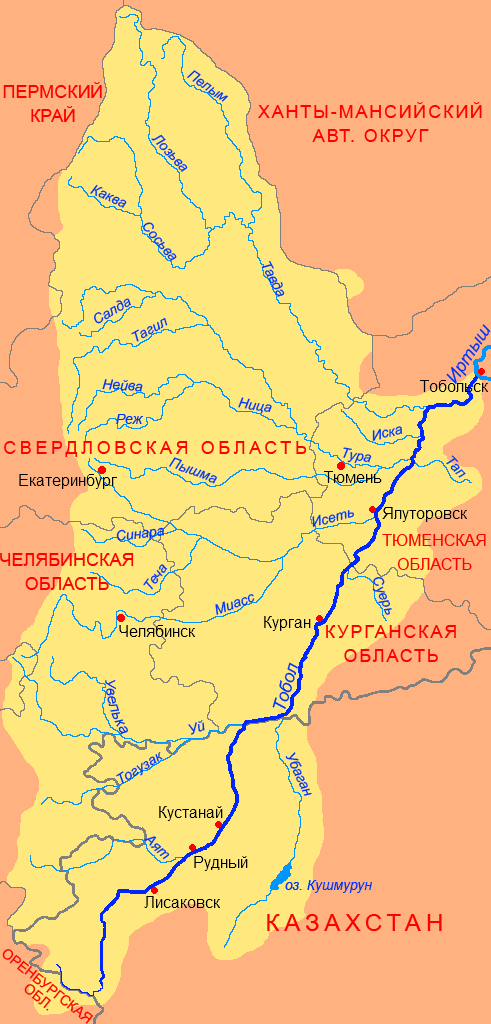|
Techa
The Techa is an eastward river on the eastern flank of the southern Ural Mountains noted for its nuclear contamination. It is long, and its basin covers . It begins by the once-secret nuclear processing town of Ozyorsk about northwest of Chelyabinsk and flows east then northeast to the small town of Dalmatovo to flow into the mid-part of the Iset, a tributary of the Tobol. Its basin is close to and north of the Miass, longer than these rivers apart from the Tobol. Water pollution From 1949 to 1956 the Mayak complex dumped an estimated of water into the Techa River, [...More Info...] [...Related Items...] OR: [Wikipedia] [Google] [Baidu] |
Mayak
The Mayak Production Association (russian: Производственное объединение «Маяк», , from 'lighthouse') is one of the biggest nuclear facilities in the Russian Federation, housing a reprocessing plant. The closest settlements are Ozyorsk to the northwest and Novogornyi to the south. Lavrentiy Beria led the Soviet atomic bomb project. He directed the construction of the Mayak Plutonium plant in the Southern Urals between 1945–48, in a great hurry and secrecy as part of the Soviet Union's atomic bomb project. Over 40,000 Gulag prisoners and POWs built the factory and the closed nuclear city of Ozersk, called at the time by its classified postal code "Forty". Five (today closed) nuclear reactors were built to produce plutonium which was refined and machined for weapons. Later the plant came to specialise in reprocessing spent nuclear fuel from nuclear reactors and plutonium from decommissioned weapons. Once production began, engineers quickly ran ... [...More Info...] [...Related Items...] OR: [Wikipedia] [Google] [Baidu] |
Ozyorsk, Chelyabinsk Oblast
Ozyorsk or Ozersk (russian: Озёрск) is a closed city in Chelyabinsk Oblast, Russia. The population was: Law #287-ZO specifies that the borders of Ozyorsky Urban Okrug match the borders of the closed administrative-territorial formation of the town of Ozyorsk. History The town was founded on the shores of Lake Irtyash in 1947. Until 1994, it was known as Chelyabinsk-65, and even earlier, as Chelyabinsk-40 (the digits are the last digits of the postal code, and the name is that of the nearest big city, which was a common practice of giving names to closed towns). Codenamed City 40, Ozersk was the birthplace of the Soviet nuclear weapons program after the Second World War. In 1994, it was granted town status and renamed Ozyorsk. Administrative and municipal status Within the framework of administrative divisions, it is, together with six rural localities, incorporated as the Town of Ozyorsk—an administrative unit with the status equal to that of the districts.Resolutio ... [...More Info...] [...Related Items...] OR: [Wikipedia] [Google] [Baidu] |
Iset (river)
The river Iset (russian: Исеть) in Russia flows from the Urals through the Sverdlovsk and Kurgan Oblasts, then through Tyumen Oblast in Western Siberia into the river Tobol. The city of Yekaterinburg is on the upper part of the river. The Iset is long, and has a drainage basin of . The Techa and the Miass Miass ( rus, Миа́сс, p=mʲɪˈas) is a city in Chelyabinsk Oblast, Russia, located west of Chelyabinsk, on the eastern slope of the Southern Ural Mountains, on the bank of the river Miass. Population: Name The name Miass is taken from ... are tributaries of the Iset. References Rivers of Sverdlovsk Oblast {{Russia-river-stub ... [...More Info...] [...Related Items...] OR: [Wikipedia] [Google] [Baidu] |
Pollution Of Lake Karachay
Lake Karachay, located in the southern Ural Mountains in eastern Russia, was a dumping ground for the Soviet Union's nuclear weapon facilities. It was also affected by a string of accidents and disasters causing the surrounding areas to be highly contaminated with radioactive waste. Although the lake has an area much smaller than that of the Fukushima Daiichi Nuclear Power Plant, and although three settlements, Ozyorsk, and some 7 kilometers away are inhabited, and the lake is surrounded by Mayak, the lake is still technically a natural area. It has been described as the "most polluted spot on Earth" by the Worldwatch Institute.Lenssen, "Nuclear Waste: The Problem that Won't Go Away", Worldwatch Institute, Washington, D.C., 1991: 15. History Built in the late 1940s, Mayak was one of Russia's most prominent nuclear weapons factories. The factory was kept secret by the government until 1990. When Russian president Boris Yeltsin signed a 1992 decree opening the area, Western ... [...More Info...] [...Related Items...] OR: [Wikipedia] [Google] [Baidu] |
Ural Mountains
The Ural Mountains ( ; rus, Ура́льские го́ры, r=Uralskiye gory, p=ʊˈralʲskʲɪjə ˈɡorɨ; ba, Урал тауҙары) or simply the Urals, are a mountain range that runs approximately from north to south through western Russia, from the coast of the Arctic Ocean to the river Ural and northwestern Kazakhstan.Ural Mountains Encyclopædia Britannica on-line The mountain range forms part of the conventional boundary between the regions of and |
Dalmatovo
Dalmatovo (russian: Далма́тово) is a town and the administrative center of Dalmatovsky District in Kurgan Oblast, Russia, located east of the Ural Mountains on the north bank of the Iset River (Tobol's tributary; Ob's basin), opposite the mouth of the Techa River, northwest of Kurgan, the administrative center of the oblast. Population: It was previously known as ''Dalmatovskoye''. History It was founded in 1644 as a ''sloboda'' next to the Dalmat Assumption Monastery, founded by a monk named Dalmat (hence, the name). Later on, this ''sloboda'' became a settlement of Dalmatovskoye (). Dalmatovo is known to have been one of the first centers of orthodoxy, literacy, and Russian culture in the Trans-Ural region in the early 18th century. It was also a place of exile for some of the Old Believers. In 1781, Dalmatovo was granted town status but then downgraded back to rural status in 1797. In the 19th century, Dalmatovo was known as a major center of cucumber cultivation ... [...More Info...] [...Related Items...] OR: [Wikipedia] [Google] [Baidu] |



